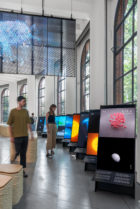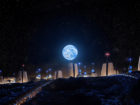Part of the European Cultural Centre’s 6th Edition of “Time Space Existence” in Venice, the installation allows visitors to experience a self-balancing vault structure created by applying new technology to traditional construction methods.
The self-supporting vault construction technique has enabled centuries of architectural innovation, including Filippo Brunelleschi’s dome for the Florence cathedral. Researchers at the Form Finding Lab and the University of Bergamo discovered that the magnificent dome may have been built using self-balancing mechanics, eliminating the need for temporary external supports during construction. Since it enables efficient material use and reduces construction waste, this technique has many applications for sustainable construction today.
To explore this, the Form Finding Lab worked with SOM, and researchers from University of Bergamo, University of Salerno, and IE University to use advanced digital methods to generate a self-balancing sculptural shape tailored to the site, the gardens of Venice’s Palazzo Mora. A prototype vault was previously built and tested at IE University’s campus in Segovia, Spain.
Built with 2000 handmade bricks made from recycled material, the doubly-curved form of the installation in Venice was constructed without temporary supports or guide work using a novel mixed-reality construction approach. A data-driven augmented reality (AR) interface enabled a skilled mason to guide the placement of each brick in a complex geometric pattern, reducing time spent reading construction drawings and assembling on-site guide work.

While the intricate, three-dimensional geometry of the vault is difficult to capture in traditional 2D construction drawings, the AR interface essentially serves as an immersive and intuitive 3D construction document, showing the mason exactly where to place each brick. The skilled mason’s manual techniques are indispensable, however. The fluid form of mortar requires the mason’s expert timing, dexterity and trained movements to ensure high-quality brickwork.
In this way, the installation presents new possibilities for digital fabrication and efficient, sustainable construction whilst demonstrating that hand-crafted qualities afforded by manual crafts cannot be replaced by digital technologies.
“The craft-based masonry assembly of the Angelus Novus Vault connects the past to the future through re-invented self-balancing brick patterns and futuristic augmented virtual reality technology and holds the promise of hope for much-needed waste-free construction practices,” said Sigrid Adriaenssens, Professor of Civil and Environmental Engineering at Princeton University.
“All of SOM’s work is concerned with developing greener ways of building. We also share with Princeton University a passion for research and developing new techniques that go further to pursue realizing structures that are more sustainable, efficient and elegant,” said Alessandro Beghini, SOM Senior Associate Principal. “Through a mixed-reality approach which removes the need for drawing documentation, Angelus Novus Vault presents a new language for bricks and the incredible potential for a more time-efficient and waste-free construction process. Formed of two plan arcs, the structure provides an elegant and memorable entrance to the Time Space Existence exhibition in the Palazzo Mora gardens.”
Construction of the vault was led by CERCAA, the Spanish training center for building crafts in Spain. The vault was built by Salvador Gomis Aviñó, a vault specialist and co-founder of CERCAA. Construction was coordinated and managed by the Italian general contractor Taramelli srl. The vault’s glulam beams were fabricated by JPF Ducret SA and the bricks were hand-manufactured by Terreal Italia srl.
An accompanying film installation by Erika A. Kiss, Director of the UCHV Research Film Studio, juxtaposes the architectonics of the universe with the human-made architecture of the built environment. The film, entitled “Assembly & Disassembly,” is viewable on an LED panel.
Unveiled to the public on May 20, “Time Space Existence” runs until November 26, 2023.



